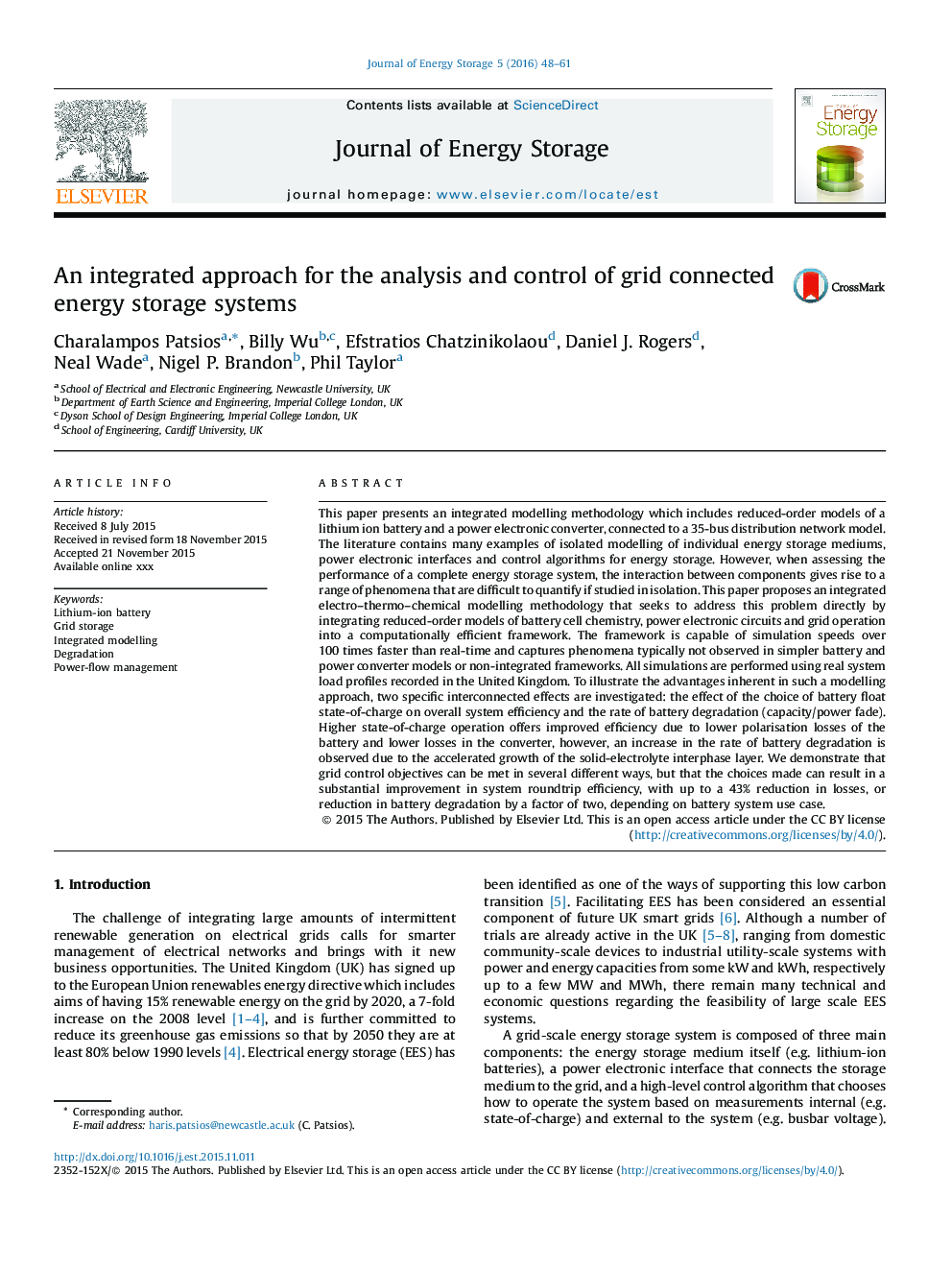| کد مقاله | کد نشریه | سال انتشار | مقاله انگلیسی | نسخه تمام متن |
|---|---|---|---|---|
| 7540353 | 1489017 | 2016 | 14 صفحه PDF | دانلود رایگان |
عنوان انگلیسی مقاله ISI
An integrated approach for the analysis and control of grid connected energy storage systems
ترجمه فارسی عنوان
یک روش یکپارچه برای تجزیه و تحلیل و کنترل سیستم های ذخیره انرژی متصل به شبکه
دانلود مقاله + سفارش ترجمه
دانلود مقاله ISI انگلیسی
رایگان برای ایرانیان
کلمات کلیدی
باتری لیتیوم یون، ذخیره سازی شبکه مدل سازی یکپارچه، تنزل، مدیریت جریان قدرت،
ترجمه چکیده
این مقاله یک روش مدل سازی یکپارچه ارائه می دهد که شامل مدل های کاهش یافته ای از یک باتری یون لیتیوم و مبدل قدرت الکترونیک است که به مدل شبکه توزیع 35 باند وصل شده است. این ادبیات شامل نمونه های بسیاری از مدل های جداگانه رسانه های ذخیره انرژی فردی، رابط های الکترونیکی قدرت و الگوریتم های کنترل ذخیره سازی انرژی است. با این حال، هنگام ارزیابی عملکرد یک سیستم ذخیره سازی کامل انرژی، تعامل بین مولفه ها به طیف وسیعی از پدیده هایی می رسند که در صورت جداگانه بررسی می شوند. این مقاله یک روش الکترو ترمو شیمیایی تلفیقی را پیشنهاد می کند که به طور مستقیم با حل یکپارچه سازی مدل های شیمیایی باطری، مدارهای الکتریکی و عملیات شبکه به یک چارچوب محاسباتی کارآمد می پردازد. این چارچوب قادر به سرعت شبیه سازی بیش از 100 بار سریعتر از زمان واقعی است و پدیده هایی را که معمولا در مدل های ساده تر باتری و مبدل های قدرتمند یا چارچوب های غیر یکپارچه مشاهده نمی شوند، ردیابی می کند. تمام شبیه سازی ها با استفاده از پرونده های سیستم بار واقعی ثبت شده در انگلستان انجام می شود. برای نشان دادن مزایای ذاتی در چنین رویکرد مدل سازی، دو اثر متقابل خاص بررسی شده است: اثر انتخاب شارژ باتری شناور بر راندمان کلی سیستم و میزان تخریب باتری (محو شدن ظرفیت / قدرت). عملکرد بالای حالت باتری موجب بهبود کارایی به علت تلفات قطبی شدن باتری و کاهش تلفات در مبدل می شود، با این وجود افزایش میزان تخلیه باتری به علت رشد سریع لایه بین فاز جامد الکترولیتی مشاهده شده است. ما نشان می دهیم که اهداف کنترل شبکه را می توان با روش های مختلفی مقابله کرد اما این انتخاب ها می تواند منجر به بهبود قابل ملاحظه ای در کارایی سیستم گردابه شده شود که با کاهش 43 درصد کاهش یا کاهش تخریب باتری با دو بار ، بسته به سیستم مورد استفاده در سیستم باتری.
موضوعات مرتبط
مهندسی و علوم پایه
مهندسی انرژی
انرژی (عمومی)
چکیده انگلیسی
This paper presents an integrated modelling methodology which includes reduced-order models of a lithium ion battery and a power electronic converter, connected to a 35-bus distribution network model. The literature contains many examples of isolated modelling of individual energy storage mediums, power electronic interfaces and control algorithms for energy storage. However, when assessing the performance of a complete energy storage system, the interaction between components gives rise to a range of phenomena that are difficult to quantify if studied in isolation. This paper proposes an integrated electro-thermo-chemical modelling methodology that seeks to address this problem directly by integrating reduced-order models of battery cell chemistry, power electronic circuits and grid operation into a computationally efficient framework. The framework is capable of simulation speeds over 100 times faster than real-time and captures phenomena typically not observed in simpler battery and power converter models or non-integrated frameworks. All simulations are performed using real system load profiles recorded in the United Kingdom. To illustrate the advantages inherent in such a modelling approach, two specific interconnected effects are investigated: the effect of the choice of battery float state-of-charge on overall system efficiency and the rate of battery degradation (capacity/power fade). Higher state-of-charge operation offers improved efficiency due to lower polarisation losses of the battery and lower losses in the converter, however, an increase in the rate of battery degradation is observed due to the accelerated growth of the solid-electrolyte interphase layer. We demonstrate that grid control objectives can be met in several different ways, but that the choices made can result in a substantial improvement in system roundtrip efficiency, with up to a 43% reduction in losses, or reduction in battery degradation by a factor of two, depending on battery system use case.
ناشر
Database: Elsevier - ScienceDirect (ساینس دایرکت)
Journal: Journal of Energy Storage - Volume 5, February 2016, Pages 48-61
Journal: Journal of Energy Storage - Volume 5, February 2016, Pages 48-61
نویسندگان
Charalampos Patsios, Billy Wu, Efstratios Chatzinikolaou, Daniel J. Rogers, Neal Wade, Nigel P. Brandon, Phil Taylor,
